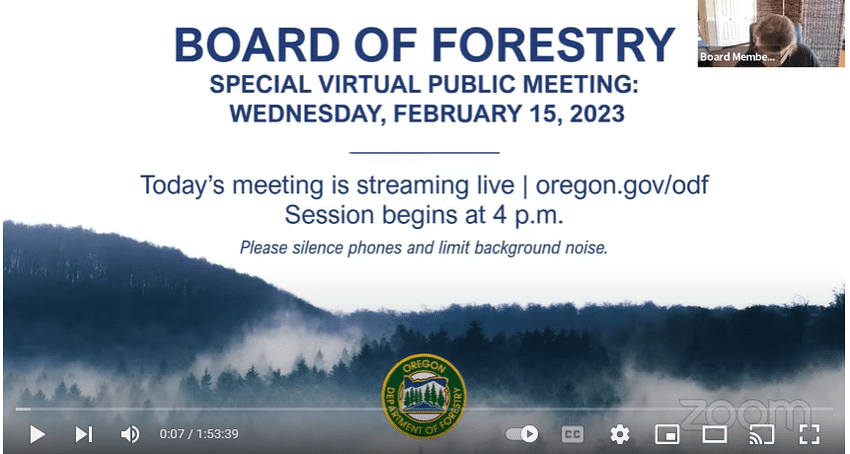By Robert Van Dyk, Wild Salmon Center
There was a very close vote in the Board of Forestry meeting yesterday (2/15/23), with three members voting to delay for at least two years and to seek higher harvest levels, while four found it prudent to stay the course and wait for more updated and relevant data.
Why the Meeting?
Chair Jim Kelly explained at the start that two members had asked to add an agenda item on state forests for March, as is their right under the board rules. Joe Justice (Hancock Forest Management) and Karla Chambers (Hampton Lumber Board Member) had asked for the added item. Because the March agenda was packed, the board added this sudden and special meeting.
Discussion of Recent Harvest Modeling
At issue was harvest levels under an upcoming Habitat Conservation Plan. An earlier harvest model predicted 225 million board feet per year of harvest. A more recent projection for a two-year transition with different assumptions predicted around 180 million board feet.
The board is due to get updated modeling later this year, at which point the board will face a decision about whether to follow the Habitat Conservation Plan developed with federal scientists.
For three board members (Justice, Chambers, Agpaoa), though, the interim modeling with different assumptions was enough to ditch the current plan and to ask for a new one that produced more harvest. Such direction from the board would have set the HCP process back at least two years, very likely longer. And it is unknown if the federal scientists would approve a plan with higher harvest, which could have sunk the entire process.
In the end, four members of the board (Ferrari, Kelly, Deumling, McComb) felt it most prudent to wait for the updated modeling (about six months from now), while three voted to start a new plan (including some of the old plan) but with a higher harvest target.
Addressing Revenue Impact of Complying with Endangered Species Act
Late in the meeting several board members spoke up in favor of working for different options for revenue, because complying with the federal Endangered Species Act on state forests might reduce revenue to some taxing districts. Several board members (Ferrari, Kelly, Deumling, McComb, Agpaoa) endorsed working with the legislature and others to find out how much money is needed, for whom, and what mechanisms might be used to address the problem.
Apparently Senator Golden (who has led tremendous forest legislation on fire protection and private forest management), has a bill up for a hearing next week that would create a taskforce to examine this problem.
The state faced a similar problem on the Elliott State Forest, where ODF managed the forest without a federal plan to comply with the Endangered Species Act. Environmental groups sued to protect rare birds. ODF had to drop many timber sales. Harvest dropped to zero. This meant that the school fund that benefited from the Elliott was not getting any revenue.
So with the leadership of Governor Brown and Treasurer Read, the legislature voted to disconnect the Elliott from the school fund, provide support for the schools, and move the Elliott to a sustainable path as a research forest where harvest will happen under a Habitat Conservation Plan.
The Board of Forestry lands present a different case in some ways. Unlike the Elliott, there is no trust relationship for the Board of Forestry lands, and harvest (and revenue) will remain quite significant going forward. But in some ways it is the same issue — complying with the Endangered Species Act affects revenue.
Let’s hope Governor Kotek can provide similar leadership for the Board of Forestry lands that Brown and Read provided for the Elliott. The bill in front of Golden’s Committee is just a task force bill at this point. But the conversation needs to start somewhere.
(Meeting is up on youtube here.)

